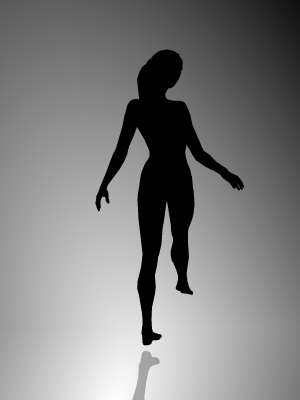Spinning dancer
(Redirected from Spinning Dancer)
Optical illusion of a spinning silhouette
The spinning dancer is a popular optical illusion that involves the perception of a two-dimensional silhouette of a dancer spinning. The illusion is notable for its ability to be perceived as spinning in either a clockwise or counterclockwise direction, depending on the viewer's interpretation. This phenomenon is often used to illustrate the concept of cognitive bias and perceptual ambiguity.
Description
The spinning dancer illusion consists of a simple animated GIF that depicts a silhouette of a dancer spinning on one foot. The animation is designed in such a way that the direction of the spin is ambiguous, allowing viewers to perceive the dancer as spinning either clockwise or counterclockwise. This ambiguity arises because the silhouette lacks depth cues, making it difficult for the brain to determine the dancer's orientation in three-dimensional space.
Perceptual Ambiguity
The spinning dancer is an example of a bistable perception, where the brain can interpret the same visual information in two distinct ways. This type of illusion highlights the brain's role in constructing reality based on limited sensory input. The direction in which the dancer appears to spin can be influenced by various factors, including the viewer's focus, mental state, and even the lighting conditions in the room.
Cognitive Bias
The spinning dancer illusion is often used to demonstrate cognitive bias, particularly in the context of left-brain versus right-brain dominance theories. Some interpretations suggest that individuals who perceive the dancer as spinning clockwise are more "right-brained," associated with creativity and intuition, while those who see it spinning counterclockwise are more "left-brained," associated with logic and analytical thinking. However, these interpretations are largely speculative and not supported by scientific evidence.
Neuroscientific Explanation
The perception of the spinning dancer can be explained by the brain's processing of visual information. The visual cortex is responsible for interpreting the ambiguous silhouette, and the lack of depth cues forces the brain to make a "best guess" about the dancer's orientation. This process involves the dorsal stream and ventral stream pathways, which are responsible for spatial awareness and object recognition, respectively.
Related Illusions
The spinning dancer is similar to other optical illusions that involve bistable perception, such as the Necker cube and the Rubin vase. These illusions also rely on the brain's interpretation of ambiguous visual information, leading to multiple possible perceptions.
Related pages
Transform your life with W8MD's budget GLP-1 injections from $125.
W8MD offers a medical weight loss program to lose weight in Philadelphia. Our physician-supervised medical weight loss provides:
- Most insurances accepted or discounted self-pay rates. We will obtain insurance prior authorizations if needed.
- Generic GLP1 weight loss injections from $125 for the starting dose.
- Also offer prescription weight loss medications including Phentermine, Qsymia, Diethylpropion, Contrave etc.
NYC weight loss doctor appointments
Start your NYC weight loss journey today at our NYC medical weight loss and Philadelphia medical weight loss clinics.
- Call 718-946-5500 to lose weight in NYC or for medical weight loss in Philadelphia 215-676-2334.
- Tags:NYC medical weight loss, Philadelphia lose weight Zepbound NYC, Budget GLP1 weight loss injections, Wegovy Philadelphia, Wegovy NYC, Philadelphia medical weight loss, Brookly weight loss and Wegovy NYC
|
WikiMD's Wellness Encyclopedia |
| Let Food Be Thy Medicine Medicine Thy Food - Hippocrates |
Medical Disclaimer: WikiMD is not a substitute for professional medical advice. The information on WikiMD is provided as an information resource only, may be incorrect, outdated or misleading, and is not to be used or relied on for any diagnostic or treatment purposes. Please consult your health care provider before making any healthcare decisions or for guidance about a specific medical condition. WikiMD expressly disclaims responsibility, and shall have no liability, for any damages, loss, injury, or liability whatsoever suffered as a result of your reliance on the information contained in this site. By visiting this site you agree to the foregoing terms and conditions, which may from time to time be changed or supplemented by WikiMD. If you do not agree to the foregoing terms and conditions, you should not enter or use this site. See full disclaimer.
Credits:Most images are courtesy of Wikimedia commons, and templates, categories Wikipedia, licensed under CC BY SA or similar.
Contributors: Prab R. Tumpati, MD


